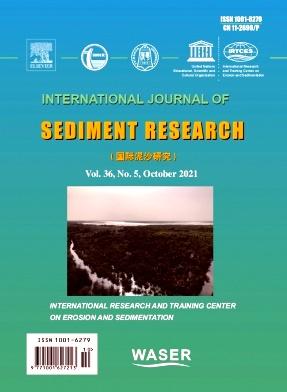Framework for reservoir sedimentation estimation using the hydrological model and campaign—A case study of A Vuong reservoir in central Vietnam
IF 3.5
2区 环境科学与生态学
Q2 ENVIRONMENTAL SCIENCES
引用次数: 0
Abstract
Sediment estimation would help practice sustainable watershed management and efficient reservoir operation. Different methods exist to estimate reservoir sedimentation based on the differences in sediment yield flowing in and releasing from the reservoir and successive bathymetric field measurements. This paper investigates the variability in sediment yield from watersheds and sedimentation in the A Vuong reservoir in central Vietnam using the soil and water assessment tool (SWAT) compared with bathymetry mapping. Bathymetry data were collected in 2003, 2015, and 2021 and conducted in 2022. SWAT was calibrated from 1996 to 2008 and validated from 2009 to 2020 using monthly observations. SWAT performs well and can accurately simulate monthly streamflow and sediment yield. The goodness-of-fit analyses suggested that the area list representation of the watershed behavior and satisfactory Sutcliffe efficiency (NSE = 0.86) values for streamflow were obtained during the calibration and validation periods. For sediment simulation, the efficiency is lower than streamflow's, with NSE in the validation values of 0.61. The results showed that the sedimentation estimate from the SWAT model is smaller than that from bathymetry. A Vuong reservoir's annual storage capacity loss due to sedimentation accumulation from the SWAT model and bathymetry was 0.08% and 0.38%, respectively. Based on the bathymetry data, we estimated that the average rate of sedimentation deposition of A Vuong reservoir was 1.3 Mm3/y. The average calculated net deposition value was 4.3 m (0.3 m per year) within fourteen years of operation. The study outcomes demonstrated that the framework approach may transfer to an ungauged catchment and address the complex sedimentation problem in tropical regions.
基于水文模型和运动的水库沉积估算框架——以越南中部阿旺水库为例
泥沙估算有助于实现流域可持续管理和水库高效运行。根据水库入沙量和出沙量的差异以及连续的水深野外测量,存在不同的水库沉积估算方法。本文利用土壤和水评价工具(SWAT)与水深测绘相比较,研究了越南中部阿旺水库流域产沙和沉积的变异性。测深数据分别于2003年、2015年和2021年收集,并于2022年进行。SWAT于1996年至2008年进行了校准,并于2009年至2020年进行了月度观测验证。SWAT表现良好,可以准确地模拟月流量和产沙量。拟合优度分析表明,在校准和验证期间,流域行为的面积表表示和流量的Sutcliffe效率(NSE = 0.86)值令人满意。泥沙模拟效率低于径流模拟,NSE在0.61的验证值内。结果表明,SWAT模型估算的沉降量小于测深法估算的沉降量。根据SWAT模型和水深测量结果,Vuong水库因泥沙淤积造成的年库容损失分别为0.08%和0.38%。根据测深资料,估计A Vuong储层的平均沉积速率为1.3 Mm3/y。在14年的运行中,平均计算净沉积值为4.3 m(每年0.3 m)。研究结果表明,框架方法可以转移到未测量的集水区,并解决热带地区复杂的沉积问题。
本文章由计算机程序翻译,如有差异,请以英文原文为准。
求助全文
约1分钟内获得全文
求助全文
来源期刊
CiteScore
6.90
自引率
5.60%
发文量
88
审稿时长
74 days
期刊介绍:
International Journal of Sediment Research, the Official Journal of The International Research and Training Center on Erosion and Sedimentation and The World Association for Sedimentation and Erosion Research, publishes scientific and technical papers on all aspects of erosion and sedimentation interpreted in its widest sense.
The subject matter is to include not only the mechanics of sediment transport and fluvial processes, but also what is related to geography, geomorphology, soil erosion, watershed management, sedimentology, environmental and ecological impacts of sedimentation, social and economical effects of sedimentation and its assessment, etc. Special attention is paid to engineering problems related to sedimentation and erosion.

 求助内容:
求助内容: 应助结果提醒方式:
应助结果提醒方式:


